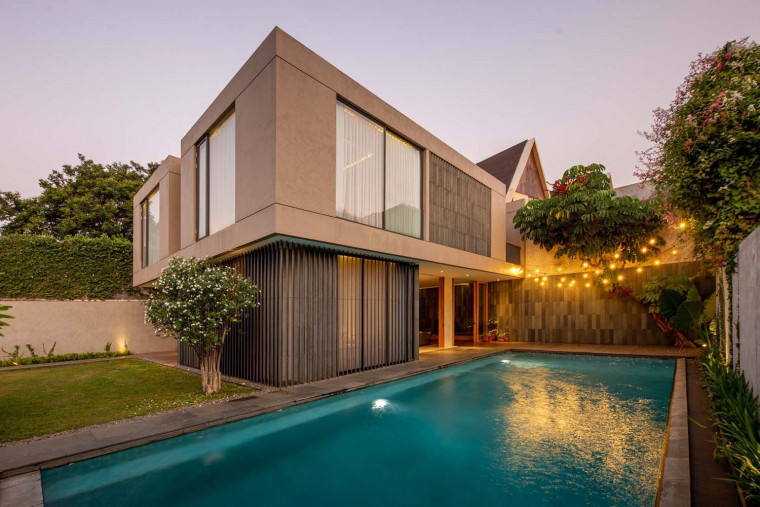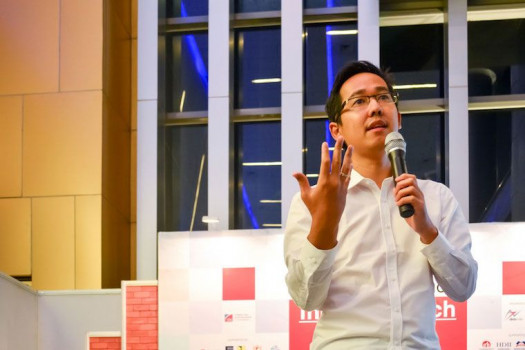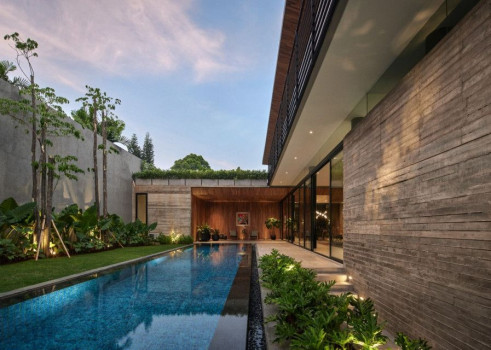Muhammad Sagitha of ArMS: “Great projects have their specific reasons of why certain materials are used”



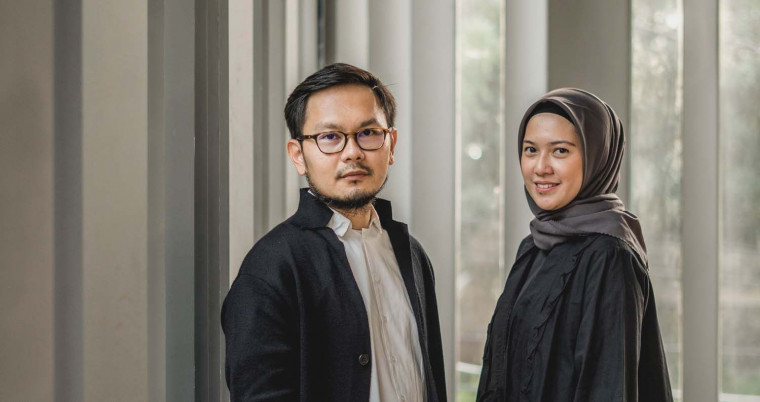
Click here for the interview in Bahasa.
With the development of material technology these days, architects and interior designers are enabled to deliver designs of various ambiance and forms. In many cases, this convenience ends with instant designs, which are done without thoughtful considerations and only to pursue trending looks and forms. It is no wonder that many designs these days are alike, if not, mundane, and at times without a context.
Discussing about material consciousness could be an initial step to avoid the culture of imitating designs and should encourage better, more thorough, design developments and explorations. Archify talked with Muhammad Sagitha, the founder of the architecture firm ArMS, regarding materiality and its role in design, as well as how ArMS’ design moves towards a more conscious way of using and selecting materials.
What do you think the role of material in design is?
Material is important in any design developments, but it is not everything. Certainly, there are numbers of things that material could influence, for example, a certain ambiance that is generated by the presence of a certain material. When we enter a room with sleek and glossy finishing, the impression of the room might feel somewhat of a modern style. Or when exposure to sunlight is high, using specific materials could create an interior with dimmed lighting that allows us to feel more relaxed. These things can be the impacts of using certain materials.
On the other hand, we know that the available commercial materials come in varying dimensions, which can affect the determination of rooms’ shape and size. Each designer may have their own responds to this. It is possible that a designer initially plans a room with the size of 3 x 4 square metres, but when they look at the material of interest, the same room could be adjusted to 3 x 4.5 square metres.
Since when did you start to develop awareness of material impact in design?
Actually, the awareness started during my college years because I had the chance to do some architectural practice. At that time, we found out how some architects planned their rooms’ dimensions based on the available size of the floor tiles. Initially, to us students, this way of designing was too complicated, especially with the outcomes that often end up with odd dimensions. Gradually, especially when I worked in Singapore, I started to find out the “magic number”: the multiplication of a certain number that can work with most materials’ dimensions. This helps a lot in creating a clean design with converging lines from the installed materials’ edges.
Are there any constant parameters you use to determine what materials are appropriate for each project?
In our architecture firm, every project that we work with has a specific storytelling. And of course, each project comes with a different context, whether it is the site or the client. With these varying contexts, the approach in designing each project could not be similar. There are clients who like industrial materials better, while some are fond of other types of material.
Take Rumah Sisik Batu as an example. When we discussed with the client, we started with some moods that they could choose to help us estimate the design directions. The initial main material being selected was timber, especially for the screen elements that functions to control the light intensity and privacy. But after considering the durability and budget, timber could not be used dominantly in that project. In the end, we used locally sourced basalt stones as a stronger, more durable material, that also suited the client’s budget.
Rumah Sisik Batu ©ArMS / Paskalis Khrisno A.
What is your thought on using real or natural material while there are many artificial materials available these days?
There was an interview with Peter Zumthor in 2009 about the use of material. On that occasion, Zumthor explained how certain features of a material could not be replaced by others. For example, in a space enveloped by timber, we can smell the aroma. This experience, of course, is non-existent in other materials or even materials that resemble timber. He gave an example, one of his works, the Bruder Klaus Field Chapel. Through this specific building, what he wanted to point out is how visitors could perceive the specific texture and aroma of burnt timber. This was done after the concrete walls were set, followed by burning the timber framework that resulted in burnt markings on the building walls.
About the availability of artificial materials today, we need to understand the design approach and the project’s directions. If we talk about a residential project that needs high quality materials for the homeowners to cherish, we could be more idealist and use more durable and irreplaceable materials. But when we talk about business and doing commercial projects with its limited budget, artificial materials might stand out as a better choice. It really depends on what is the target of the project.
Besides to create specific ambience, is there another consideration in choosing such natural materials?
Usually, these materials have way longer lifetime than the artificial ones. Take granite slab as an example—one of its characteristics is homogeneity in the whole slab which means the material can be always be polished to look new. The feel and look of granite is different from surfaces made from clay, cement, or other man-made materials that attempts to emulate natural materials.
More than that, materials could help to represent a certain design styles and define contexts. Great projects have their specific reasons of why certain materials are used.
Does ArMS limits the number of main materials being used in a project?
When I worked in Singapore, we explored quite a lot of materials and as a consequence, there are many details of joinery between different materials that needed to be settled—how varying materials can be combined well, look interesting, and has proper joinery. Along the way, we sometimes think that using many materials at once is just too much. Clearly, the more materials we use, the more issues will arise and the more experts will be involved.
For instance, if we design a door using a combination of timber, glass and metal, it is possible that the parties involved are not just a door supplier, but also timber and metal supplier. If we only need to coordinate with one party for an element of design, there will be less challenge. And when we select fewer materials, we could turn the focus more on spatial quality and the joinery detail.
In the end, this is about taste. There are people who like strikingly colourful apparel, there are also those who prefer monochromatic clothes. The numbers of material being used really depend on each project and its respective clients. There are clients who think one material is enough, while other thinks that using only one material would be monotonous.

Alkahf Creative Space ©ArMS / Ernest Theofilus
Does ArMS use one specific material that becomes its signature?
So far, there is no specific material that we repeatedly use in every project, because it tends to become boring at some point. It is possible to meet a client who thinks that a certain material is new to them even though it is frequently used on previous projects. Thus, the design style and the choice of specific material has never been intentional. We do not want to design with a specific material that people would know it is ArMS’ works. I think this kind of design approach is somewhat too instant. We prefer that the realised design is unpredictable and every material selected has its proper reason to be used in that project.
Think about it, the use of certain material is similar to trends. When someone uses a particular material and turns out to be good, everyone else will try the same thing. What might be interesting is if the utilisation of natural materials in Indonesia could be like Japan, of which I heard through one of Kengo Kuma’s presentations in 2008. In Japan, there is a certain regulation that refrains a local material to be used outside its prefecture. Similar situation in Indonesia is when, for example, Yogyakarta’s stone is trending, the material will spread to different parts of Java, to Sumatra and other islands. It would be nicer if we have the regulation that is similar to the one in Japan, so that it is not the material that spreads across the country, but the craftsmen instead. This way, each region could have their own specific characteristics.
What are some recent projects of ArMS that showcase interesting use of material?
This year we finished several projects that utilise bricks as the main material. The construction workers were experts, diligent and quite precise with their works. With a modest material—bricks, not even the expensive ones—the highlight was on their craftsmanship and the result was surprisingly good. Talking about craftsmanship, this is what we should not overlook. We need to appreciate the workers’ craft takes patience and delicacy. With this, it is possible to generate exceptionally good result even with the simplest and the most modest materials.
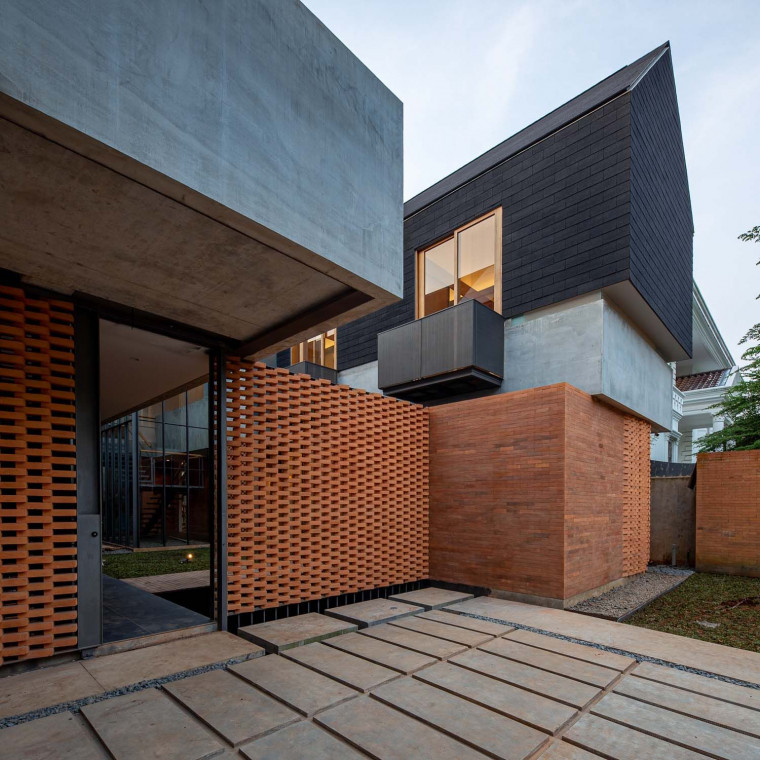
Rumah Geser ©ArMS / Paskalis Khrisno A.
What do you think of today’s craftsmanship and its relation to material and design?
I think handmade and bespoke products resulting from craftsmanship will be a luxury in the future. In the middle of the market that are full of efficient, easy-to-work-with materials, expert workers will become more limited. It is a good thing if these two opposing sides are not conflicting or competing, but instead complementing each other. Craftsmanship are for personal and specific projects, while fabricated materials are for projects that need to be efficient and mass-produced.
What could happen if more designers are more aware of and appreciate materiality?
In the future, the cost of construction will keep rising and clients might be more mindful in determining how much space needed to be built. If more people are aware of and appreciate material and craftsmanship, maybe people will choose quality rather than quantity. We can see how these days people are still inclined to spaciousness, but when everything gets more expensive, more compact space with quality material and larger outdoor space might be a better choice.
By limiting the square-metre and usage of materials, construction waste will of course be reduced. Without explicitly promoting Green architecture, being efficient in using materials at the least could bring design to a more sustainable direction.
Dengan berkembangnya teknologi material saat ini, arsitek dan desainer interior dapat dengan mudah menghasilkan desain dengan berbagai suasana dan bentukan ruang. Tak jarang, kemudahan tersebut mengakibatkan hasil desain yang instan, tanpa pertimbangan, dan demi mengejar tampak atau wujud yang sedang populer. Wajar, kini banyak desain yang cenderung seragam, bahkan monoton, dan terkadang tidak sesuai dengan konteks.
Berbicara tentang kesadaran material bisa jadi merupakan langkah awal untuk menghindari sikap latah dan dapat menjadi penggerak perkembangan dan eksplorasi desain yang lebih baik. Archify berbicara dengan Muhammad Sagitha, pendiri biro arsitektur ArMS, terkait material: perannya dalam desain, dan bagaimana desain ArMS bergerak melalui kesadaran terhadap pemanfaatan material.
Menurut Anda, apa peran material dalam desain?
Material memang penting dalam pengembangan desain. Tapi material bukan segalanya. Ada beberapa hal yang bisa dipengaruhi material, misalnya suasana ruangan yang tercipta melalui penggunaan material tertentu. Ketika kita masuk ke ruangan dengan finishing yang sleek, glossy, mungkin kesan ruangan yang tercipta menjadi serasa lebih modern. Atau ketika di sisi luar bangunan terasa panas, penggunaan material tertentu bisa menghasilkan ruang dalam yang redup sehingga mata lebih tenang dan suasananya cocok untuk beristirahat. Hal-hal seperti ini bisa diciptakan oleh material.
Di sisi lain, kita bisa lihat material yang tersedia di pasaran dimensinya berbeda-beda. Fakta tersebut juga dapat mempengaruhi pertimbangan desainer dalam menentukan dimensi ruang. Bagaimana seorang desainer merespons hal tersebut bisa jadi berbeda satu sama lain. Bisa jadi seorang desainer ketika di awal mendesain ruangan berukuran 3 x 4 meter, namun ketika mempertimbangkan penggunaan material tertentu, ruangan tersebut menjadi 3 x 4,5 meter.
Sejak kapan kesadaran terhadap material seperti itu terbentuk? Bagaimana prosesnya?
Sebenarnya sejak kuliah mulai terbentuk kesadaran terhadap material karena sempat berpraktik langsung. Kami juga mendengar bagaimana beberapa arsitek mendesain ruang berdasarkan ukuran keramik yang ada. Awalnya, menurut kami yang masih kuliah, hal itu terlalu rumit apalagi hasilnya ruangan memiliki ukuran yang aneh supaya material yang dipakai tidak terpotong. Lambat laun, khususnya saat bekerja di Singapura, mulai kenal dengan sebutan “magic number” yang berupa kelipatan angka tertentu yang sesuai dengan kebanyakan ukuran material. Ini juga sangat membantu untuk menghasilkan desain yang rapi dengan garis-garis material yang saling bertemu.
Apakah ada parameter tetap yang Anda pakai untuk menentukan material yang cocok untuk setiap proyek?
Di kantor kami, setiap proyek yang kami kerjakan memiliki satu storytelling tertentu. Dan pastinya setiap proyek juga punya konteks yang berbeda-beda, baik dari site dan kliennya. Nah dengan konteks yang berbeda, tentu pendekatan setiap proyek juga tidak bisa sama. Ada klien yang senang dengan material yang industrial, ada juga yang lebih suka jenis material lain.
Sebagai contoh, proyek Rumah Sisik Batu. Saat berdiskusi dengan klien, kami menunjukkan beberapa mood yang bisa mereka pilih sehingga kami bisa membaca arahan yang bisa kami tawarkan ke klien. Penentuan material saat itu diawali dengan menggunakan kayu khususnya untuk elemen screen yang mengatur intensitas masuknya matahari dan privasi. Namun dari segi budgeting dan ketahanan, ternyata kayu belum bisa digunakan secara dominan di proyek tersebut. Akhirnya kita memilih batu basalt lokal sebagai material yang lebih kuat, tahan lama, dan sesuai dengan budget klien.
Apa pandangan Anda terhadap penggunaan material yang asli/natural di tengah banyak berkembangnya material artificial saat ini?
Ada interview dengan Peter Zumthor di 2009 yang saya ingat terkait material. Saat itu Zumthor bercerita bahwa ada beberapa sifat material yang memang tidak tergantikan oleh material lain. Misal bagaimana suasana saat masuk ke ruangan yang penuh dengan tekstur kayu yang bahkan aromanya bisa dirasakan. Hal itu tidak bisa digantikan oleh material lain atau bahkan material yang menyerupai kayu. Dia memberi contoh salah satu karyanya, Bruder Klaus Field Chapel. Lewat karya tersebut, yang ingin ia tonjolkan adalah bagaimana pengunjung dapat merasakan tekstur dan bau yang spesifik, yaitu kayu yang terbakar. Caranya, setelah beton tercetak, bekisting kayu dibakar sehingga ada sisa-sisa bekas bakaran kayu yang membekas pada dinding bangunan. Itu contoh suasana yang tidak bisa digantikan oleh material lain atau artificial.
Terkait kehadiran material artificial sebenarnya kembali ke pendekatan desain dan arah proyeknya. Bila berbicara soal proyek residential yang membutuhkan kualitas yang bagus dan untuk dinikmati sendiri, maka kita cenderung berpikir idealis dan material yang dipilih lebih ke material yang kokoh dan tidak bisa tergantikan. Namun ketika berpikir secara bisnis dan budgeting khususnya untuk proyek komersial, mungkin di sini material substitusi atau artificial berbicara. Tinggal bergantung pada target yang seperti apa.
Selain suasana yang tercipta, apakah ada hal lain yang biasa ingin dicapai dengan menggunakan jenis material yang tidak tergantikan?
Biasa material non substitusi memiliki umur yang jauh lebih panjang. Misalnya granit, material asli granit memiliki kulit dan sisi dalam yang sama dan bisa terus di-polish agar terlihat baru. Berbeda dengan saat ini ketika feel dan look granit bisa diciptakan dari clay, semen, dan material lain yang hanya kulitnya saja untuk menciptakan suasana yang bisa mendekati ke arah tersebut.
Selain itu, sebenarnya material bisa mencerminkan gaya desain dan menjelaskan konteks. Proyek yang dikerjakan dengan sangat baik akan memiliki alasan yang spesifik untuk menjawab mengapa suatu material digunakan.
Dalam mendesain, apakah ArMS menentukan batasan jumlah material utama dalam setiap proyek?
Ketika bekerja di Singapura, banyak material yang dieksplorasi dan tentu sambungan antar material harus diselesaikan—bagaimana material-material tersebut bisa dikombinasikan dengan baik, menarik, dan dengan sambungan yang bagus. Beriring dengan waktu, kami kadang menganggap itu menjadi terlalu berlebihan. Yang jelas, semakin banyak material, semakin banyak juga masalah yang perlu diselesaikan dan semakin banyak tenaga ahli yang dilibatkan.
Misalnya saat mendesain pintu dengan kayu, kaca, dan besi. Bisa jadi yang terlibat bukan hanya supplier pintu, namun juga melibatkan supplier kayu dan besi yang harus saling berkoordinasi. Kalau hanya berkoordinasi dengan satu pihak untuk sebuah elemen, tentu akan memudahkan untuk mencari solusi. Dan ketika material yang dipilih sedikit, perhatiannya bisa bergeser ke kualitas ruang dan detail sambungan antar material yang sama.
Pada akhirnya ini berbicara tentang selera. Ada yang senang dengan baju yang warna-warni yang saling bertabrakan, ada juga yang senang dengan baju monokrom. Jadi jumlah material sangat bergantung pada setiap proyek dan kliennya masing-masing. Ada klien yang cukup satu material saja, tetapi ada juga yang merasa satu material akan terlalu monoton.
Apakah ada material spesifik yang selalu dipakai ArMS dalam setiap proyek?
Sejauh ini tidak ada yang benar-benar spesifik dan terus diulang, karena cenderung akan menjadi bosan. Bisa saja bertemu dengan klien yang malah merasa baru dengan satu material yang sudah banyak dipakai di proyek-proyek sebelumnya. Maka itu, style desain dan pemilihan material spesifik tidak pernah kami sengajakan. Kami tidak ingin mendesain dengan material tertentu sehingga orang tahu bahwa itu adalah desain ArMS. Rasanya dengan pendekatan seperti itu, desain menjadi terlalu instan. Kami malah ingin agar desain yang tercipta tidak tertebak dan setiap pemilihan material memiliki alasan yang tepat untuk dipakai di proyek tersebut.
Penggunaan material juga seperti tren. Ketika ada yang menggunakan material A dan hasilnya bagus, akhirnya semua mencoba hal yang sama. Yang menarik sebenarnya adalah seandainya pemanfaatan material alami di Indonesia bisa seperti di Jepang yang saya dengar lewat salah satu presentasi Kengo Kuma di 2008. Di Jepang, ada regulasi khusus tentang material lokal yang tidak boleh berpindah dari satu tempat. Kondisi di Indonesia adalah ketika, misal, batu Jogja menjadi tren, material tersebut pasti menyebar dan digunakan di Jawa, Sumatera, dan pulau-pulau lain. Alangkah bagusnya kalau terdapat regulasi tersebut, yang bisa dikirim bukan material, melainkan tenaga kerjanya. Dengan demikian setiap daerah punya ciri khas spesifik yang tidak tersebar ke tempat lain yang kalau tidak bisa berujung menjadi monoton.
Contoh proyek dengan pemanfaatan material yang menarik?
Tahun ini kami menyelesaikan beberapa proyek menggunakan material bata. Kebetulan pekerjanya juga sangat ahli, tekun, dan presisi. Jadi dengan material yang sangat sederhana—bata, yang bahkan bukan jenis bata mahal—yang ditonjolkan adalah craftsmanship-nya, sehingga hasilnya juga menjadi bagus. Berbicara tentang ketukangan, hal-hal seperti ini yang tidak ingin kita kurangi. Kita tetap ingin mengapresiasi keahlian tukang sehingga kesulitan, detail, dan durasi pekerjaan bisa benar-benar menghasilkan sesuatu yang bagus, bahkan dari material yang sederhana.
Apa pendapat Anda tentang perkembangan craftsmanship kaitannya dengan pengolahan material dan desain?
Menurut saya sesuatu yang handmade dan spesifik seperti craftsmanship akan menjadi satu hal yang mewah. Di tengah pasar yang didominasi material yang mudah dikerjakan, tentu tukang yang ahli akan semakin langka. Baiknya dua kubu ini tidak saling bertabrakan atau berlomba-lomba, namun saling melengkapi. Yang craftsmanship untuk proyek-proyek yang personal dan spesifik, dan material pabrikasi untuk hal yang butuh efisiensi dan pengerjaan yang masal.
Menurut Anda, apa dampaknya ketika semakin banyak yang merancang dengan kesadaran dan apresiasi terhadap material?
Ke depan, tentu pembangunan semakin mahal dan klien akan semakin berhati-hati dalam menentukan besaran dan luasan bangunan. Bila semakin banyak yang sadar dan bisa mengapresiasi material dan kualitas craftsmanship, mungkin orang akan cenderung memilih kualitas daripada luasan. Saat ini kebanyakan orang masih berfoya-foya dengan ukuran ruangan yang luas, ketika ke depannya semua menjadi sangat mahal, ruangan yang kecil dengan material yang berkualitas dan taman yang besar mungkin menjadi pilihan.
Dengan luasan dan penggunaan material yang dibatasi, tentu limbah bangunan juga akan semakin berkurang. Tanpa embel-embel green architecture, dengan berpikir terhadap efisiensi penggunaan material setidaknya mulai menggerakkan desain ke arah yang lebih sustainable.




 Indonesia
Indonesia
 Australia
Australia
 Philippines
Philippines
 Hongkong
Hongkong
 Singapore
Singapore
 Malaysia
Malaysia


